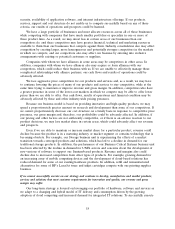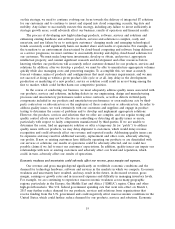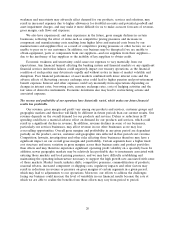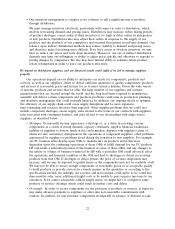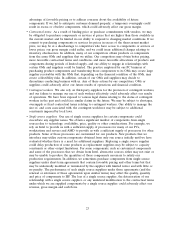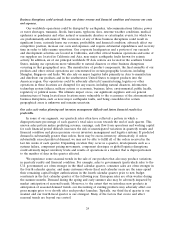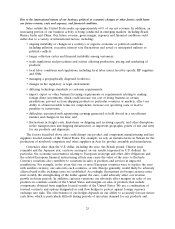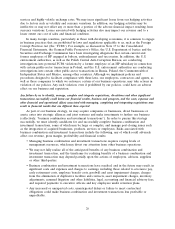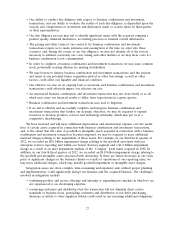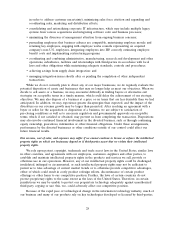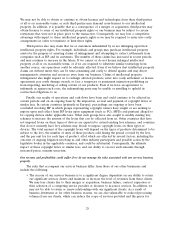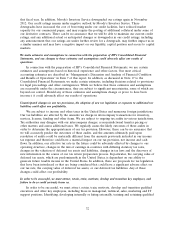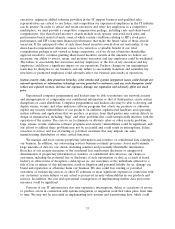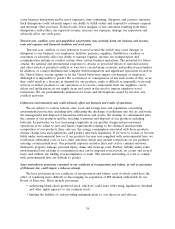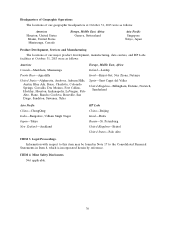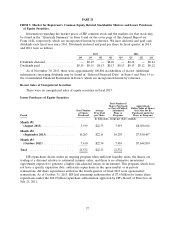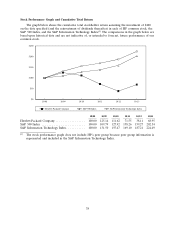HP 2013 Annual Report Download - page 36
Download and view the complete annual report
Please find page 36 of the 2013 HP annual report below. You can navigate through the pages in the report by either clicking on the pages listed below, or by using the keyword search tool below to find specific information within the annual report.in order to address customer uncertainty), minimizing sales force attrition and expanding and
coordinating sales, marketing and distribution efforts;
• consolidating and rationalizing corporate IT infrastructure, which may include multiple legacy
systems from various acquisitions and integrating software code and business processes;
• minimizing the diversion of management attention from ongoing business concerns;
• persuading employees that business cultures are compatible, maintaining employee morale and
retaining key employees, engaging with employee works councils representing an acquired
company’s non-U.S. employees, integrating employees into HP, correctly estimating employee
benefit costs and implementing restructuring programs;
• coordinating and combining administrative, manufacturing, research and development and other
operations, subsidiaries, facilities and relationships with third-parties in accordance with local
laws and other obligations while maintaining adequate standards, controls and procedures;
• achieving savings from supply chain integration; and
• managing integration issues shortly after or pending the completion of other independent
transactions.
While we do not currently plan to divest any of our major businesses, we do regularly evaluate the
potential disposition of assets and businesses that may no longer help us meet our objectives. When we
decide to sell assets or a business, we may encounter difficulty in finding buyers or alternative exit
strategies on acceptable terms in a timely manner, which could delay the achievement of our strategic
objectives. We may also dispose of a business at a price or on terms that are less desirable than we had
anticipated. In addition, we may experience greater dis-synergies than expected, and the impact of the
divestiture on our revenue growth may be larger than projected. After reaching an agreement with a
buyer or seller for the acquisition or disposition of a business, we are subject to satisfaction of
pre-closing conditions as well as to necessary regulatory and governmental approvals on acceptable
terms, which, if not satisfied or obtained, may prevent us from completing the transaction. Dispositions
may also involve continued financial involvement in the divested business, such as through continuing
equity ownership, guarantees, indemnities or other financial obligations. Under these arrangements,
performance by the divested businesses or other conditions outside of our control could affect our
future financial results.
Our revenue, cost of sales, and expenses may suffer if we cannot continue to license or enforce the intellectual
property rights on which our businesses depend or if third-parties assert that we violate their intellectual
property rights.
We rely upon patent, copyright, trademark and trade secret laws in the United States, similar laws
in other countries, and agreements with our employees, customers, suppliers and other parties, to
establish and maintain intellectual property rights in the products and services we sell, provide or
otherwise use in our operations. However, any of our intellectual property rights could be challenged,
invalidated, infringed or circumvented, or such intellectual property rights may not be sufficient to
permit us to take advantage of current market trends or to otherwise provide competitive advantages,
either of which could result in costly product redesign efforts, discontinuance of certain product
offerings or other harm to our competitive position. Further, the laws of certain countries do not
protect proprietary rights to the same extent as the laws of the United States. Therefore, in certain
jurisdictions we may be unable to protect our proprietary technology adequately against unauthorized
third-party copying or use; this, too, could adversely affect our competitive position.
Because of the rapid pace of technological change in the information technology industry, much of
our business and many of our products rely on key technologies developed or licensed by third-parties.
28


